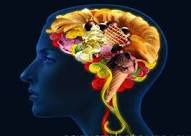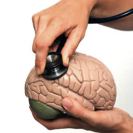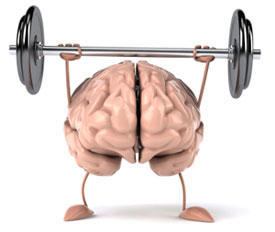There’s no denying that as we age chronologically, our body ages right along with us. But research is showing that you can increase your chances of maintaining a healthy brain well into your old age if you add these “smart” foods to your daily eating regimen.
Blueberries. “Brainberries” is what Steven Pratt, MD, author of Superfoods Rx: Fourteen Foods Proven to Change Your Life, calls these tasty fruits. Pratt, who is also on staff at Scripps Memorial Hospital in La Jolla, Calif., says that in animal studies researchers have found that blueberries help protect the brain from oxidative stress and may reduce the effects of age-related conditions such as Alzheimer’sdisease or dementia. Studies have also shown that diets rich in blueberries significantly improved both the learning capacity and motor skills of aging rats, making them mentally equivalent to much younger rats. Ann Kulze, MD, author ofDr. Ann’s 10-Step Diet: A Simple Plan for Permanent Weight Loss & Lifelong Vitality, recommends adding at least 1 cup of blueberries a day in any form — fresh, frozen, or freeze-dried.
Wild salmon. Deep-water fish, such as salmon, are rich in omega-3 essential fatty acids, which are essential for brain function, says Kulze. Both she and Pratt recommend wild salmon for its “cleanliness” and the fact that it is in plentiful supply. Omega-3s also contain anti-inflammatory substances. Other oily fish that provide the benefits of omega-3s are sardines and herring, says Kulze; she recommends a 4-ounce serving, two to three times a week.
Nuts and seeds. Nuts and seeds are good sources of vitamin E, says Pratt, explaining that higher levels of vitamin E correspond with less cognitive decline as you get older. Add an ounce a day of walnuts, hazelnuts, Brazil nuts, filberts, almonds, cashews, peanuts, sunflower seeds, sesame seeds, flax seed, and unhydrogenated nut butters such as peanut butter, almond butter, and tahini. Raw or roasted doesn’t matter, although if you’re on a sodium-restricted diet, buy unsalted nuts.
Avocados. Avocados are almost as good as blueberries in promoting brain health, says Pratt. “I don’t think the avocado gets its due,” agrees Kulze. True, the avocado is a fatty fruit, but, says Kulze, it’s a monounsaturated fat, which contributes to healthy blood flow. “And healthy blood flow means a healthy brain,” she says. Avocados also lower blood pressure, says Pratt, and as hypertension is a risk factor for the decline in cognitive abilities, a lower blood pressure should promote brain health. Avocados are high in calories, however, so Kulze suggests adding just 1/4 to 1/2 of an avocado to one daily meal as a side dish.
My name is Art Noel. I have long been a health advocate. I love nature and truly believe that we walk among God’s gifts for our well being. I have studied and continue to study Bio-Energetics, Thought Field Therapy, Brain Nutrition, Body/Organ Nutrition, and The Law of Attraction. I love to share my findings and never pass anything along I do not firmly believe in.
It is obvious that in our current society we tend to neglect out health and rely excessively on modern medicine. We put things into our bodies that is foreign to it and destructive to it. This includes our brain. Our brain runs every aspect of our bodies and when at deaths door the brain is the last to die. Our brain will do anything, including killing certain organs so that the heart will be the last to cease thus when nothing is left, the brain ceases.
Folks, we should be asking ourselves every day what we can do for our brain and our bodies. We take better care of our possessions than we do our bodies but without this shell we call our bodies we have nothing. “Understand, your brain is like a finely tuned sports car. When you take care of it, give it the best fuel, and don’t take it for granted, it can perform beautifully, helping you to stay focused, calm, and happy. But, just like every other organ in your body, it needs the right fuel and maintenance to function at its peak and to continue running at high performing levels, not just for short periods at a time, but all the time for the rest of your life. Unfortunately, most people do very little to maximize their brain’s performance, which leads to issues like lack of focus, anxiety, depression, poor sleep, brain fog, memory loss, addictions, physical pain, and so much more.” Brain Abundance
I am currently promoting a new product that has had a profound impact on myself and other members of my family. It is call Brain Fuel Plus. I will warn you it is not cheap but I feel we owe it to ourselves. Brain Fuel PLUS is the FIRST and ONLY product available ANYWHERE that combines THIRTEEN of most powerful ingredients to help feed, support, and maximize healthy brain performance. If you want more out of life and care about your body you can check it out here.
Thank you for visiting my site and may you always be healthy.
Art Noel
For those of you who have diabetes, I found this article and the site quite interesting. I have always promoted healthy eating and natural supplements.
Type 2 Diabetes Mellitus is a rapidly growing epidemic. Obesity has been identified as one of the main risks for this disease and increased intake of saturated fat and sugar increases the risk to develop Obesity and Type 2 Diabetes Mellitus. Our first interest is to understand how nutrients affect the brain and how these changes mediate the overeating as observed in (most) obese people. Secondly, although peripheral actions of both fat and sugar will affect glucose metabolism, it does not explain why some obese individuals become diabetic and why others do not. We therefore focus on the effects of nutrients on the brain as an alternative route via which high caloric diets might mediate the development of diabetes.
We study these research questions with a translational approach using both diet-induced obese animals and human experimental studies. This translational approach is possible because of a close collaboration with the group of Mireille Serlie within the Department of Endocrinology and Metabolism and the group of Jan Booij from the Department of Nuclear Medicine. http://www.susannelafleur.com/research.html

1) Within the brain several regions are involved in feeding regulation. We focus on both the hypothalamus, that responds to signals of hunger and satiety and generates the daily rhythm in feeding, and the cortico-limbic system which is involved in rewarding aspects of feeding and motivation to eat. We use different approaches to study the effects of diet composition on the brain and on feeding regulation. We use a) diets with a free-choice of saturated fat and a sugar solution in addition to normal nutritionally balanced chow, as a recognized efficient diet to induce overeating, obesity, insulin resistance and beta cell insufficiency; b) intracarotic catheter infusions to directly deliver nutrients to the brain, c) short term overfeeding studies in healthy volunteers and d) studies in obese subjects.

2) We have shown that animals consuming saturated fat and a sugar solution in addition to regular nutritionally balanced chow rapidly develop insulin resistance and glucose intolerance due to an insufficient insulin response, features preceding diabetes. These changes in glucose metabolism were not explained by obesity since animals consuming saturated fat in addition to chow did become obese but not glucose intolerant. We also showed specific alterations in several regions in the brain due to the diet, not only at the level of the hypothalamus but also in the striatum. To determine whether these alterations in brain are important for glucose metabolism we use both our animal models as well as human experimental studies to determine the role of these changes in glucose metabolism. http://www.susannelafleur.com/research.html
Scientists at the Salk Institute have discovered the developmental source for a key type of neuron that allows animals to walk, a finding that could help pave the way for new therapies for spinal cord injuries or other motor impairments related to disease.
The spinal cord contains a network of neurons that are able to operate largely in an autonomous manner, thus allowing animals to carry out simple rhythmic walking movements with minimal attention – giving us the ability, for example, to walk while talking on the phone. These circuits control properties such as stepping with each foot or pacing the tempo of walking or running.
The researchers, led by Salk professor Martyn Goulding, identified for the first time which neurons in the spinal cord were responsible for controlling a key output of this locomotion circuit, namely the ability to synchronously activate and deactivate opposing muscles to create a smooth bending motion (dubbed flexor-extensor alternation). The findings were published in Neuron.
Motor circuits in the spinal cord are assembled from six major types of interneurons – cells that interface between nerves descending from the brain and nerves that activate or inhibit muscles. Goulding and his team had previously implicated one class of interneuron, the V1 interneurons, as being a likely key component of the flexor-extensor circuitry. However when V1 interneurons were removed, the team saw that flexor-extensor activity was still intact, leading them to suspect another type of cell was also involved in coordinating this aspect of movement.
To determine what other interneurons were at play in the flexor-extensor circuit, the team looked for other cells in the spinal cord with properties that were similar to those of the V1 neurons. In doing this they began to focus on another class of neuron, whose function was not known, V2b interneurons. Using a specialized experimental setup that allows one to monitor locomotion in the spinal cord itself, the team saw a synchronous pattern of flexor and extensor activity when V2b interneurons were inactivated along with the V1 interneurons.
The team also showed that this synchronicity led to newborn mice displaying a tetanus-like reaction when the two types of interneurons were inactivated: the limbs froze in one position because they no longer had the push-pull balance of excitation and inhibition that is needed to move.
These findings further confirm the hypothesis put forward over 120 years ago by the Nobel Prize-winning neuroscientist, Charles Sherrington, that flexor-extensor alternation is essential for locomotion in all animals that have limbs. He proposed that specialized cells in the spinal cord called switching cells performed this function. After 120 years, Goulding and researchers have now uncovered the identity of these switching cells.
“Our whole motor system is built around flexor-extension; this is the cornerstone component of movement,” says Goulding, holder of Salk’s Frederick W. and Joanna J. Mitchell Chair. “If you really want to understand how animals move you need to understand the contribution of these switching cells.”
With a more thorough understanding of the basic science around how this flexor-extensor circuit works, scientists will be in a better position to, for example, create a system that can reactivate the spinal cord or mimic signals sent from the brain to the spinal cord.
It is estimated that as many as 80% of people around the world have some form of neurological challenge; whether it’s something small like the inability to stay focused for long periods of time, something more serious like always feeling stressed out, anxious, depressed, or not able to sleep, or something much more severe like dementia or alzheimers. Whatever it is, Brain Fuel PLUS may be able to help!
As you are probably aware, your brain is the most powerful organ in your body. And when functioning correctly can mean the difference between a stressed out day filled with anxiety and concern, and a happy, balanced, focused day filled with joy and calmness.
Understand, your brain is like a finely tuned sports car. When you take care of it, give it the best fuel, and don’t take it for granted, it can perform beautifully, helping you to stay focused, calm, and happy. But, just like every other organ in your body, it needs the right fuel and maintenance to function at its peak and to continue running at high performing levels, not just for short periods at a time, but all the time for the rest of your life.
Unfortunately, most people do very little to maximize their brain’s performance, which leads to issues like lack of focus, anxiety, depression, poor sleep, brain fog, memory loss, addictions, physical pain, and so much more.

This is a great article and a must read.
The stress hormone cortisol can negatively affect memory and learning ability in the elderly. Researchers found that showing a 20-minute funny video to healthy seniors and seniors with diabetes helped them score better on memory tests and significantly reduced their cortisol levels when compared to non-video watchers.
Their findings were presented on Sunday, April 27, at the Experimental Biology meeting.
Gurinder Singh Bains et al. showed a 20-minute laugh-inducing funny video to a group of healthy elderly individuals and a group of elderly people with diabetes. The groups where then asked to complete a memory assessment that measured their learning, recall, and sight recognition. Their performance was compared to a control group of elderly people who also completed the memory assessment, but were not shown a funny video. Cortisol concentrations for both groups were also recorded at the beginning and end of the experiment.
The research team found a significant…
View original post 286 more words
Watch the video. The impact I have witnessed has been profound. I take many supplements but at age 60 sometimes things don’t seem to have much of an impact. This product has broke the barriers and I truly believe in it.
With my skills in Bio-Energetics and Thought Field Therapy, this all make perfect sense.
Your thoughts create your reality. Your brain transmits your thoughts to your vital organs. Bad thoughts = bad feelings and possible bad health. Good thoughts = good feelings and possible good health.
I found this to be inspiring and very beautiful.
One of my most favorite hymns is “Christmas Has It’s Cradle, Easter Has It’s Cross” by Rae E. Whitney. Although probably sung most often at Christmas than at Easter, I think it is a hymn that is equally appropriate for both celebrations. After all, the hymn’s lyrics link Christmas with Easter. Without Christmas there would be no Easter. The two most important celebrations in Christian history are inseparably linked together, all part of God’s perfect plan to redeem the world.
Christmas has its cradle, where a Baby cried; did the lantern’s shadow show him crucified?
Did he foresee darkly His life’s willing loss?
Christmas has its cradle and Easter has its cross.
Christmas has its cradle; shepherds came to see, Little Son of Mary, Lamb of God to be
Had His Father warned Him, none would grant Him room, save in the Christmas cradle and in the Easter tomb?
Christmas has its cradle, wise…
View original post 115 more words




